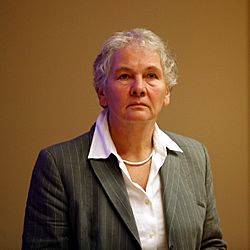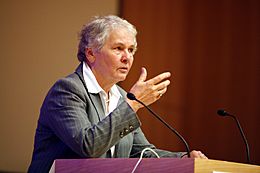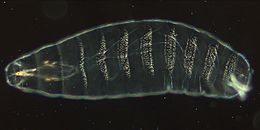Christiane Nüsslein-Volhard facts for kids
Quick facts for kids
Christiane Nüsslein-Volhard
|
|
|---|---|
 |
|
| Born | 20 October 1942 Magdeburg, Germany
|
| Education | Goethe University Frankfurt University of Tübingen (PhD) |
| Relatives | Franz Volhard (grandfather)), Benjamin List (nephew) |
| Awards |
|
| Scientific career | |
| Fields | |
| Institutions |
|
| Thesis | Zur spezifischen Protein-Nukleinsäure-Wechselwirkung : die Bindung von RNS-Polymerase aus Escherichia coli an die Replikative-Form-DNS des Bakteriophagen fd und die Charakterisierung der Bindungsstellen (1974) |
| Doctoral advisor | Heinz Schaller |
Christiane Nüsslein-Volhard (born October 20, 1942) is a famous German scientist who studies how living things grow and develop. In 1995, she won the Nobel Prize in Physiology or Medicine for her amazing discoveries. She is the only German woman ever to win a Nobel Prize in a science category.
Her work focused on genetics, which is the study of genes. Genes are like tiny instruction manuals inside every cell that tell the body how to grow and work. Nüsslein-Volhard wanted to understand which genes control the development of an embryo (an animal in its earliest stage of life).
Along with her partners Eric Wieschaus and Edward B. Lewis, she figured out the basic genetic rules for how an embryo develops. Their work has helped scientists all over the world understand growth, birth defects, and even diseases like cancer.
Contents
Early Life and Schooling
Christiane Nüsslein-Volhard was born in Magdeburg, Germany, during World War II. She was the second of five children. Her father was an architect, and her mother was a nursery school teacher. Growing up, she was encouraged to appreciate art and music, which taught her to look at things closely. Her family had other famous scientists, including her great-grandfather, the chemist Jacob Volhard, and her grandfather, the doctor Franz Volhard.
After finishing high school in 1962, she thought about becoming a doctor. But after working in a hospital for a month, she decided it wasn't for her. Instead, she chose to study biology at Goethe University Frankfurt.
Later, she moved to the University of Tübingen to study biochemistry. She chose this field because it was new and exciting. She said, "I was ambitious — I wanted to go where the leaders were." She earned her PhD (the highest university degree) in 1974.
A Groundbreaking Career
In 1975, Nüsslein-Volhard began working at a lab in Basel, Switzerland. There, she started studying the development of the fruit fly, Drosophila melanogaster. Fruit flies are very useful in science because they grow up quickly and are easy to study.
In 1978, she and another scientist, Eric Wieschaus, started their own lab in Heidelberg, Germany. They began a huge experiment to find the genes that control how a fruit fly embryo develops. This was a massive project that took three years to complete.
The Famous Fruit Fly Experiment
Nüsslein-Volhard and Wieschaus wanted to find every gene that was important for building a baby fly's body. To do this, they used a chemical to cause random changes, or mutations, in the flies' genes. They then looked at thousands of fly embryos under a microscope to see what went wrong when a certain gene was changed.
They paid close attention to the fly larva's body, which is made of repeating parts called segments. By looking at how the segments were formed, they could figure out what job each gene had. For example, if a gene was broken and the embryo was missing segments, they knew that gene was needed to create those segments.
They gave the genes funny and descriptive names based on how the mutated flies looked. Some famous examples are:
- Hedgehog: This gene caused the fly larvae to look spiky, like a hedgehog.
- Gurken: This is German for "cucumbers," because the eggs looked short and fat like a cucumber.
- Krüppel: This is German for "cripple," because flies with a mutation in this gene were missing the middle part of their body.
By 1980, they had identified 120 key genes that guide the early development of a fruit fly. This was a huge breakthrough in science.
Why Her Research Matters
Nüsslein-Volhard's discoveries were revolutionary. She showed how a small number of genes could create a complex body plan from a single cell. Her work didn't just apply to fruit flies. Many of the genes she found in flies have similar versions in other animals, including humans.
This means that studying fruit fly genes can help us understand human development and diseases. Her findings also changed how scientists think about evolution. It suggested that many different types of animals, from insects to humans, might share a common ancestor that was more complex than previously thought.
Later in her career, she began studying the zebrafish to understand how vertebrates (animals with backbones) develop.
Helping Women in Science
In 2004, Nüsslein-Volhard started the Christiane Nüsslein-Volhard Foundation. Its goal is to help young female scientists in Germany who are also mothers. The foundation provides money to help them pay for childcare so they can focus on their important research.
Personal Life
Nüsslein-Volhard lives in Bebenhausen, a small town in Germany. She enjoys singing, playing the flute, and making music with others. She even published a cookbook in 2006.
Awards and Honors
Christiane Nüsslein-Volhard has received many awards for her incredible contributions to science.
- 1986: Gottfried Wilhelm Leibniz Prize, one of Germany's most important research awards.
- 1991: Albert Lasker Award for Basic Medical Research, often called "America's Nobel."
- 1992: Louis-Jeantet Prize for Medicine.
- 1995: Nobel Prize in Physiology or Medicine, which she shared with Eric Wieschaus and Edward B. Lewis.
- 1997: Pour le Mérite for Sciences and Arts, a high honor in Germany.
- 2005: Grand Merit Cross with Star and Sash, one of Germany's highest civilian awards.
She has also received honorary degrees from many of the world's top universities, including Harvard, Yale, Princeton, Oxford, and Cambridge. The asteroid 15811 Nüsslein-Volhard is also named after her.
See also
 In Spanish: Christiane Nüsslein-Volhard para niños
In Spanish: Christiane Nüsslein-Volhard para niños



